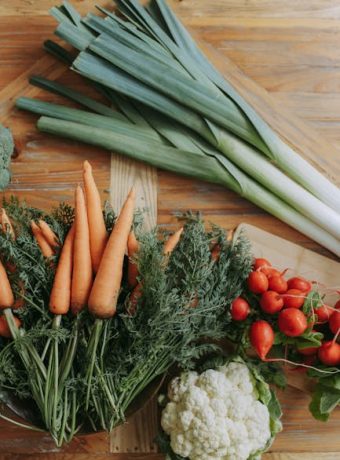Fall Vegetables: Nutrient-Packed Choices for the Season
As the vibrant hues of autumn leaves begin to blanket the ground, the season also brings a bounty of nutrient-dense vegetables that are perfect for hearty and healthy meals. Fall is the ideal time to explore a diverse range of vegetables that not only add color to your plate but also pack a nutritional punch. In this blog post, we’ll delve into some of the best fall vegetables, their health benefits, and how you can incorporate them into your diet.
The Health Benefits of Fall Vegetables
Fall vegetables are rich in vitamins, minerals, and antioxidants that support overall health. From boosting your immune system to improving digestion, these vegetables offer a multitude of health benefits. Let’s take a closer look at some of the key advantages:
Boosted Immunity
Many fall vegetables, such as sweet potatoes and pumpkins, are high in beta-carotene, which the body converts into vitamin A. This vitamin is crucial for a healthy immune system, helping to ward off infections and illnesses.
Improved Digestion
Vegetables like brussels sprouts and kale are excellent sources of dietary fiber, which is essential for maintaining a healthy digestive system. Fiber aids in regular bowel movements and prevents constipation.
Heart Health
Leafy greens such as spinach and collard greens are rich in potassium and magnesium, which help regulate blood pressure and support cardiovascular health. These vegetables also contain antioxidants that reduce inflammation and promote heart health.
Top Fall Vegetables to Include in Your Diet
With a wide variety of fall vegetables to choose from, it’s easy to add both flavor and nutrition to your meals. Here are some of the top fall vegetables you should consider incorporating into your diet:
Sweet Potatoes
Sweet potatoes are a versatile and delicious fall vegetable that can be used in a variety of dishes. They are rich in beta-carotene, vitamin C, and potassium. One medium sweet potato provides over 400% of your daily recommended intake of vitamin A. Try roasting them, mashing them, or adding them to soups and stews for a nutritious boost.
Brussels Sprouts
Brussels sprouts are a member of the cruciferous vegetable family and are packed with vitamins C and K, as well as fiber. They are also known for their anti-inflammatory properties. Roast them with a drizzle of olive oil and a sprinkle of sea salt for a tasty side dish.
Butternut Squash
Butternut squash is a fall favorite that is high in vitamins A and C, as well as fiber and potassium. Its sweet, nutty flavor makes it a great addition to soups, salads, and risottos. You can also roast it with herbs and spices for a simple yet delicious side dish.
Kale
Kale is a nutrient powerhouse, offering an abundance of vitamins A, C, and K, as well as calcium and antioxidants. It can be used in salads, smoothies, and soups. For a crunchy snack, try baking kale leaves with a touch of olive oil and sea salt to make kale chips.
Beets
Beets are rich in folate, manganese, and nitrates, which help improve blood flow and lower blood pressure. Their earthy flavor pairs well with goat cheese and walnuts in salads. You can also roast beets for a sweet and savory side dish.
Carrots
Carrots are a great source of beta-carotene, fiber, and vitamins K and C. They can be enjoyed raw as a snack, roasted as a side dish, or added to soups and stews. Carrot juice is also a refreshing way to boost your nutrient intake.
Spinach
Spinach is a versatile leafy green that is rich in iron, calcium, and vitamins A and C. It can be used in salads, smoothies, and cooked dishes like lasagna and quiches. Fresh spinach is also a great addition to sandwiches and wraps.
How to Incorporate Fall Vegetables into Your Meals
Adding fall vegetables to your diet doesn’t have to be complicated. Here are some simple and delicious ways to enjoy these nutrient-packed choices:
Roasted Vegetable Medley
Combine a variety of fall vegetables such as sweet potatoes, brussels sprouts, butternut squash, and carrots. Toss them with olive oil, salt, and pepper, and roast in the oven at 400°F for 25-30 minutes. This medley makes a flavorful and colorful side dish.
Hearty Vegetable Soup
Make a warming vegetable soup by combining butternut squash, carrots, kale, and beets in a vegetable broth. Add garlic, onions, and herbs for extra flavor. Simmer until the vegetables are tender, then blend for a smooth and creamy texture.
Fall Harvest Salad
Create a nutritious salad with a mix of spinach, roasted beets, and brussels sprouts. Top with goat cheese, walnuts, and a simple vinaigrette made with olive oil, balsamic vinegar, and honey. This salad is perfect for a light lunch or side dish.
Stuffed Acorn Squash
Cut acorn squash in half and scoop out the seeds. Fill the cavities with a mixture of quinoa, spinach, cranberries, and nuts. Bake at 375°F for 45 minutes, or until the squash is tender. This dish is both visually appealing and nutritious.
Conclusion
Fall vegetables are not only delicious but also packed with essential nutrients that support overall health. By incorporating a variety of these vegetables into your meals, you can enjoy the flavors of the season while reaping the numerous health benefits they offer. From sweet potatoes and brussels sprouts to kale and butternut squash, there are endless ways to savor the bounty of fall. So, head to your local farmers market or grocery store and start experimenting with these nutrient-packed choices today!


